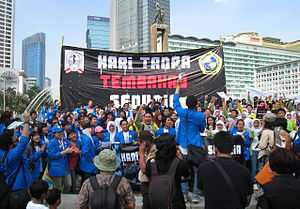Tobacco control movement

Tobacco control is a field of public health science, policy and practice dedicated to controlling (i.e. restricting) the growth of tobacco use and thereby reducing the morbidity and mortality it causes. References to a tobacco control movement may have either positive or negative connotations, both briefly covered here.
Positive connotations
The tobacco control field comprises the activity of disparate health, policy and legal research and reform advocacy bodies across the world. These took time to coalesce into a sufficiently organised coalition to advance such measures as the World Health Organization Framework Convention on Tobacco Control, and the first article of the first edition of the Tobacco Control journal suggested that developing as a diffusely organised movement was indeed necessary in order to bring about effective action to address the health effects of tobacco use.[1]
Negative connotations
The tobacco control movement has also been referred to as an anti-smoking movement by some who disagree with the movement, as documented in internal tobacco industry memoranda.[2]
See also
- Tobacco control
- World No Tobacco Day
- Action on Smoking and Health
- Anti-Cigarette League of America
- FCTC
- List of smoking bans
- National Non-Smoking Week
- Smoking age
- Smoking ban
- Smoking bans in private vehicles
- Tobacco lobby
- Tobacco-Free Pharmacies
- Patrick Reynolds, an anti-smoking activist
- Philip Morris v. Uruguay
- Anti-tobacco movement in Nazi Germany
- Word of Wisdom
References
- ↑ Davis, Ronald (March 1992). "The slow growth of a movement". Tobacco Control 1 (1). Retrieved 2011-10-04.
- ↑ P.L. Berger (1991). "The Anti-Smoking Movement in Global Perspective". Philip Morris memorandum, accessed through tobaccodocuments.org. Retrieved 2009-01-09.
| |||||||||||||||||||||||||||||||||||||||||||||
